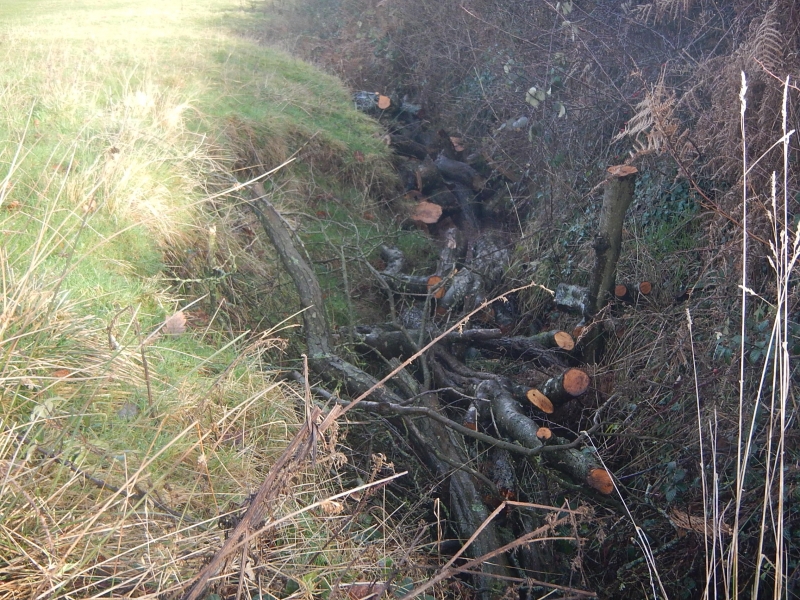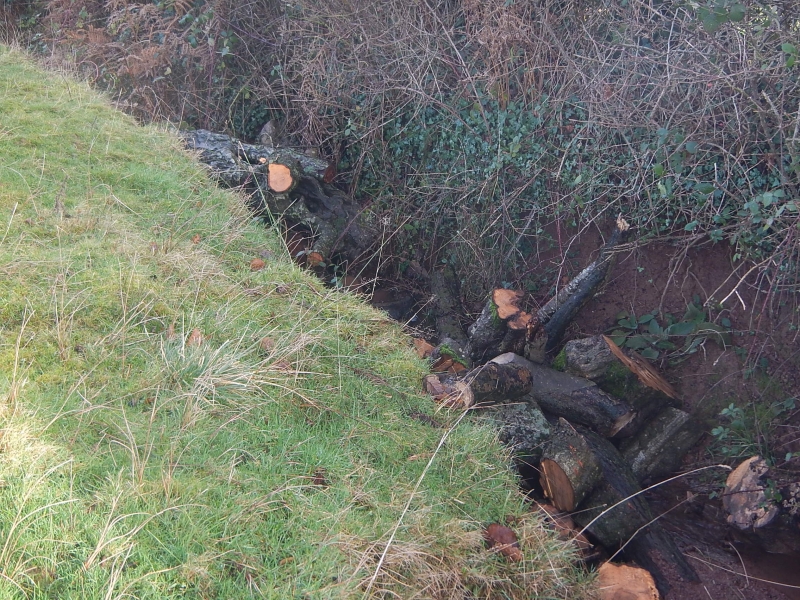In ditch seepage at Jamie's Farm
The Herefordshire Natural Flood Management (NFM) construction grant scheme aims to reduce flood risk to local communities, as well as improve water quality and enhance biodiversity, using natural flood management processes.
The scheme runs until March 2027 and provides funding to help support landowners and farmers to alter their land and water management practices to slow the flow of water and reduce flood risk to downstream communities.
View the NFM construction grant scheme for more details and eligibility
In ditch seepage case study
 "Water speed has slowed in the ditch, hopefully this will reduce the typical flooding and erosion issues this winter."
"Water speed has slowed in the ditch, hopefully this will reduce the typical flooding and erosion issues this winter."
Mark Carnie, Farm Manager
What is an in-ditch seepage barrier?
In-ditch seepage barriers are designed to slow the flow of water travelling through the ditch. They can be created using natural materials, such as those built at Jamie’s Farm, or by installing wooden slats across the ditch, either vertically or horizontally, leaving gaps of 1-2 mm in between each slat.
What are the benefits?
- Flood risk reduction – By slowing down the flow of water, the in-ditch seepage barrier helps to reduce the flood peak, helping to reduce the flood risk to downstream communities.
- Reduced soil erosion – The in-ditch seepage barrier helps reduce soil erosion, by slowing the flow of water, which in turn reduces the erosive power of the water.
- Improved water quality – By slowing down the flow of water, sediment can be deposited, helping to remove nutrients and pesticides from the water.
- Improved aquatic environment downstream – By improving the water quality flowing out of the ditch, the in-ditch seepage barrier helps to create a better environment for aquatic invertebrates and fish that live downstream.
“Water flow speed in the ditch has slowed considerably in the section where woody debris was placed and sediment is beginning to build up. Hopefully vegetation will take to this next spring and help protect eroding banks.”
Mark Carnie, Farm Manager
Site details
- Location: Jamie's Farm, Lower Wern Ddu, Longtown, Hereford
- Water course: Dulas brook
- NFM Project Catchment area: Dulas brooks
- Ownership: Jamie's Farm
- Designations: None
- Protected species: None
Story at Jamie's Farm
Jamie's Farm, Hereford is mixed farm located in the Dulas brook catchment. The farm is one of five farms managed by Jamie's Farm, a charity which runs unique residential experiences for vulnerable young people. The farm provides young people the opportunity to combine farming, family and therapy.
When approached by Tom Jolley, a Catchment Advisor from the Wye and Usk Foundation about the NFM project, the farm were keen to get involved. Following a site visit and discussions with Jamie’s Farm, a ditch was identified on the farm that receives large volumes of fast flowing water during wet weather conditions. The erosive power of the water flowing down the ditch was causing large amounts of soil erosion and was resulting in the ditch undercutting the hedge that runs parallel to it.
To tackle these issues, Jamie’s Farm installed a large in-ditch seepage barrier within this ditch which is approximately 100 m in length. Staff at the farm, including staff with chainsaw qualifications, used timbre from the farms recent tree and hedge coppicing operations to create the barrier. The in-ditch seepage barrier is now helping to slow the flow of water within the ditch, which helps to reduce flood risk and prevent soil erosion.
NFM details
What was implemented?
- Large natural in-ditch seepage barrier, approximately 100 m in length
Costs
- River Wye and Lugg NFM Project Construction Grant Scheme NFM16 Landowner Innovation value of: £718.56
- Total cost: £718.56
Who did the work?
- Landowner - Jamie's Farm
Consents
- Ordinary Watercourse Flood Defence Consent (FDC) – In accordance with Section 23 of the Land Drainage Act 1991, Herefordshire Council as the Lead Local Flood Authority are responsible for ensuring alterations to watercourses will not increase flood risk. FDC consent was therefore required for the in-ditch seepage barrier installed at Jamie’s Farm. NFM Project Officer applied for this consent on behalf of the landowner.
Interview with the landowner
Mark Carnie, the Farm Manager at Jamie’s Farm Hereford gave us this useful insight into the works on his farm:
How did you find out about the River Wye and Lugg NFM Project?
We were approached regarding the project by Tom Jolley from the Wye and Usk Foundation who asked if we would like to be involved. We have worked with the Wye and Usk Foundation previously to improve water quality and soil health.
What has the funding enabled you to do?
Create leaky barriers within a ditch to slow water flow and reduce soil erosion.
What changes to your land have you noticed since implementing the Natural Flood Management?
Water flow speed in the ditch has slowed considerably in the section where woody debris was placed and sediment is beginning to build up. Hopefully vegetation will take to this next spring and help protect eroding banks.
What are the impacts to your business?
Hopefully any flooding issues relating to the ditch will be reduced this winter.
Have you seen the NFM working during a heavy rainfall event, if so what did you notice?
Yes, water speed has slowed in the ditch, hopefully this will reduce the typical flooding and erosion issues this winter.
How have you found the experience?
Working with the project has been good, interesting and straightforward. We are always looking to make environmental improvements to the farm and working with the project has been interesting and straightforward.
Will you continue to adopt Natural Flood Management practices in the future? If so which ones?
Yes, we are looking at improving water quality and reducing erosion through more riparian fencing of watercourses (slowing flow through bank roughness) and we always look to improve our soil health.
Have you implemented any other NFM on your land which hasn’t been funded through the River Wye and Lugg NFM Construction Grant scheme? If so what have you implemented and how was it funded?
Yes we are in Mid-Tier Countryside Stewardship. This includes options such as Riparian Management Strips on water courses, establishing hedges across water flow lines and diverse herbal rich (deep rooting) leys to improve soil structure (better water infiltration and holding capacity).
Any tips or advice?
Get in touch with the project.
Herefordshire Council would like to thank all involved for their support with implementing NFM at Jamie’s Farm. This work forms part of the Defra funded River Wye and Lugg Natural Flood Management Project.



